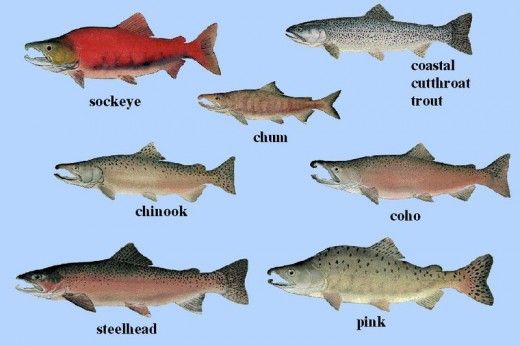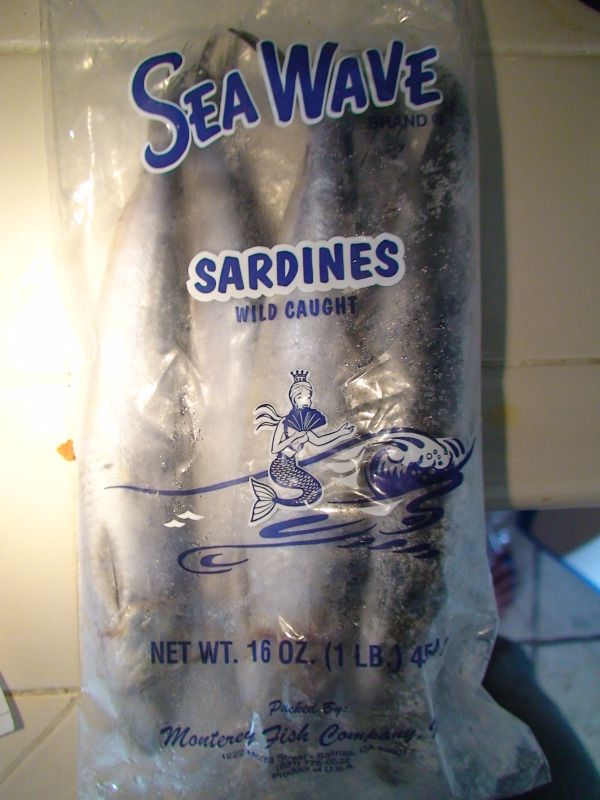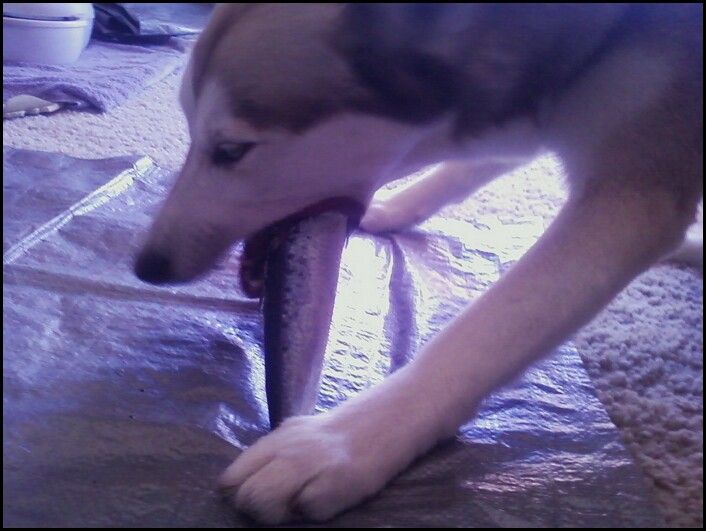In a raw diet feeding raw fish is not necessary, but the right fish offer good variety and can be beneficial. Fish is not a main part of a
wild canid's diet (or of cats, despite what cartoons would have you believe) so ideally it shouldn't be a main part of your dog's diet but it's fine to feed often. It's ok to never feed fish, and it's ok to add fish every day. One reason I like to add fish is because it's possible to feed the complete, whole animal including the organs that are tough to get in a regular grocery store separately.
The best fish to feed are oily ones like mackerel,
sardines, herring, anchovies, and smelt. This is because they offer Omega 3s; scroll down to the bit about fish oil for more info. Wild-caught salmon is also good but farm-raised salmon is
high in mercury (more on that below too) and also high in other toxic chemicals. I would personally steer clear of all farm-raised salmon. Other than salmon, to my knowledge, any farm-raised store-bought fish
is fine to feed and there is no need to worry about parasites or anything else. If you
aren't sure if the fish was wild or farmed then freeze it for a couple weeks just to be safe. Non-oily fish like tilapia is pointless to feed unless you're
desperate for variety. If you're looking to add fish, skip the tilapia.
If you do choose for some reason to give tilapia it may be wise to cut off any spiky fins. With sardines, mackerel,
etc. you don't need to cut anything off. The fish should be fed whole. Head to
tail, skin and scales, guts included. Removing the head or guts is removing nutrition.
Make sure the fish is raw. Do not buy cooked, canned, smoked, breaded, or seasoned fish. Whole fish are best and I personally wouldn't bother feeding any kind of filet or gutted/headless fish.
Make sure the fish is raw. Do not buy cooked, canned, smoked, breaded, or seasoned fish. Whole fish are best and I personally wouldn't bother feeding any kind of filet or gutted/headless fish.
Some dogs don't like fish very much or seem puzzled when a whole fish is set in front of them. Try cutting the fish in
half or making some deep slices into it at first to get the dog interested. Do this when
the fish is still semi-frozen or else guts come out and it's extra
smelly and disgusting. I typically feed the fish semi-frozen to keep the smell and goo at a minimum. Denali refused all fish at first and thought they were revolting. She would snort and curl her lips and shake her fur. She loves them now and I'm not sure why she changed her mind. Don't stock up your freezer until you're sure the dog will eat it.
As mentioned in the Bacteria & Parasites post, most fish are fine to feed but there is specific concern with wild-caught salmonids in the Pacific Northwest of the United States. "Salmonids" includes salmon of course (see pic) but also trout, whitefish, grayling, and char. These specific fish in this specific location from southern Alaska to mid California may have the parasite responsible for salmon poisoning. Freezing the fish solid will kill the parasite. One week of freezing is surely enough, but 2 weeks is what I would personally do. If you are not comfortable feeding these specific wild-caught fish from this area due to the chance of the parasite being present then simply don't feed it. Again, fish is not a necessary part of a dog's diet and there are other good options for fish to feed anyway.
As mentioned in the Bacteria & Parasites post, most fish are fine to feed but there is specific concern with wild-caught salmonids in the Pacific Northwest of the United States. "Salmonids" includes salmon of course (see pic) but also trout, whitefish, grayling, and char. These specific fish in this specific location from southern Alaska to mid California may have the parasite responsible for salmon poisoning. Freezing the fish solid will kill the parasite. One week of freezing is surely enough, but 2 weeks is what I would personally do. If you are not comfortable feeding these specific wild-caught fish from this area due to the chance of the parasite being present then simply don't feed it. Again, fish is not a necessary part of a dog's diet and there are other good options for fish to feed anyway.
Mercury levels are also important to know. I keep this picture on hand and only buy fish in the low category. Fish in the medium category are ok to feed but don't feed them as often or in large quantities. Personally I would avoid any fish in the high category, which includes farmed and Atlantic salmon. Other sea critters like crab, crawfish, and scallops are listed here as well. These are basically in the same category with tilapia of being pointless variety for dogs. If you're going to feed anything that comes from the ocean, make it worthwhile by feeding oily fish and skip the rest.
At the grocery store we shop at I can find whole frozen sardines, so that's what I get. They are $2/lb here which is about twice what I like to pay for food for the pets. I find them in the frozen food aisle. If the main grocery store doesn't have anything good then check Asian markets as they typically have a wider variety of fish. Again, stick to the oily fish! I usually give each dog one fish, once or twice a week. The price is one reason I don't give it more. If they were very cheap I might give a fish 4-5x a week or even 1/2 fish every day but I like to keep things cheap.
On a final note I want to mention that yes, fish bones are fine to feed as long as they are raw. There is no need to worry about the dog choking on them or about the bones causing harm to the dog's digestive tract. Raw fish bones are very soft and flexible and they digest easily. Cooking the bones makes them brittle. Brittle bones break into sharp pointy little shards capable of causing harm. Raw bones only! Fish is great for dentally challenged dogs or cats who may not have any teeth or have bad teeth and cannot chomp down on harder bones, or for cats who don't seem to "get" chomping and eating bones. Fish bones are often so small that cats will eat them easily. Bones are an important part of a raw diet and if a dog has trouble with bigger or harder bones then fish bones are a great option- Cornish game hens and rabbits are also great for those dogs to get bone in their diet.





No comments:
Post a Comment